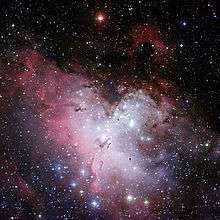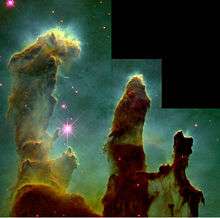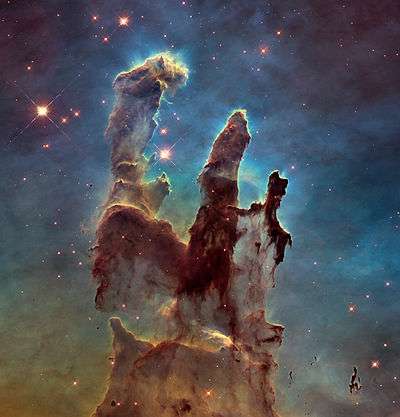Eagle Nebula
| Emission nebula | |
|---|---|
| H II region | |
 Three-colour composite mosaic image of the Eagle Nebula. Credit: ESO | |
| Observation data: J2000.0 epoch | |
| Right ascension | 18h 18m 48s[1] |
| Declination | −13° 49′[1] |
| Distance | 7,000 ly |
| Apparent magnitude (V) | +6.0[1] |
| Apparent dimensions (V) | 7.0 arcmins |
| Constellation | Serpens |
| Physical characteristics | |
| Radius | 70×55 (cluster 15) ly |
| Absolute magnitude (V) | -8.21 |
| Notable features | 1–2 million years old |
| Designations | Messier 16, NGC 6611,[1] Sharpless 49, RCW 165, Gum 83, Star Queen Nebula |
The Eagle Nebula (catalogued as Messier 16 or M16, and as NGC 6611, and also known as the Star Queen Nebula and The Spire) is a young open cluster of stars in the constellation Serpens, discovered by Jean-Philippe de Chéseaux in 1745–46. Both the "Eagle" and the "Star Queen" refer to visual impressions of the dark silhouette near the center of the nebula,[2][3] an area made famous as the "Pillars of Creation" photographed by the Hubble Space Telescope. The nebula contains several active star-forming gas and dust regions, including the Pillars of Creation.
Characteristics
The Eagle Nebula is part of a diffuse emission nebula, or H II region, which is catalogued as IC 4703. This region of active current star formation is about 7000 light-years distant. A spire of gas that can be seen coming off the nebula in the northeastern part is approximately 9.5 light-years or about 90 trillion kilometers long.[4]
The cluster associated with the nebula has approximately 8100 stars, which are mostly concentrated in a gap in the molecular cloud to the north-west of the Pillars.[5] The brightest star (HD 168076) has an apparent magnitude of +8.24, easily visible with good binoculars. It is actually a binary star formed of an O3.5V star plus an O7.5V companion.[6] This star has a mass of roughly 80 solar masses, and a luminosity up to 1 million times that of the Sun. The cluster's age has been estimated to be 1–2 million years.[7]
The descriptive names reflect impressions of the shape of the central pillar rising from the southeast into the central luminous area. The name "Star Queen Nebula" was introduced by Robert Burnham, Jr., reflecting his characterization of the central pillar as the Star Queen shown in silhouette.[8]
"Pillars of Creation" region
Images taken by Jeff Hester and Paul Scowen using the Hubble Space Telescope in 1995 greatly improved scientific understanding of processes inside the nebula. One of these photographs became famous as the "Pillars of Creation", depicting a large region of star formation. The small dark areas in the photograph are believed to be protostars (Bok globules). The pillar structure of the region resembles that of a much larger star formation region in the Soul Nebula of Cassiopeia, imaged with the Spitzer Space Telescope in 2005[9] and characterized as "Pillars of Star Creation".[10] or "Pillars of Star Formation".[11] These columns – which resemble stalagmites protruding from the floor of a cavern – are composed of interstellar hydrogen gas and dust, which act as incubators for new stars. Inside the columns and on their surface astronomers have found knots or globules of denser gas, called EGGs ("Evaporating Gaseous Globules"). Stars are being formed inside some of these EGGs.
X-ray images from the Chandra observatory compared with Hubble's "Pillars" image have shown that X-ray sources (from young stars) do not coincide with the pillars, but instead randomly dot the area.[12] Any protostars in the pillars' EGGs are not yet hot enough to emit X-rays.
Evidence from the Spitzer Telescope suggests that the pillars in M16 may already have been destroyed by a supernova explosion. Hot gas observed by Spitzer in 2007 suggests that the area was disturbed by a supernova that exploded some 8000 to 9000 years ago. Due to the distance of the nebula, the light from the supernova would have reached Earth between 1000 and 2000 years ago. The more slowly moving shock wave from the supernova would have taken a few thousand years to move through the nebula, and would blow away the delicate pillars – but the light showing us the destruction will not reach the Earth for another millennium.[13]
Gallery
 Locator of well-known areas in the nebula
Locator of well-known areas in the nebula The "Pillars of Creation" within the Eagle Nebula
The "Pillars of Creation" within the Eagle Nebula Detail of the HST image
Detail of the HST image A higher-resolution HST image of the "Pillars of Creation" was taken 20 years after the original.
A higher-resolution HST image of the "Pillars of Creation" was taken 20 years after the original.
 HST infrared view
HST infrared view The "Black Pillar" spire on the eastern perimeter is about 9.5 light-years long.
The "Black Pillar" spire on the eastern perimeter is about 9.5 light-years long. Open cluster within the Eagle Nebula
Open cluster within the Eagle Nebula Northwestern part of the region, well away from the centre
Northwestern part of the region, well away from the centre
See also
References
- 1 2 3 4 "SIMBAD Astronomical Database". Results for NGC 6611. Retrieved 2006-11-16.
- ↑ Martin MacPhee (8 July 2014). "The awesome beauty of M16, the Eagle Nebula". EarthSky. Retrieved 25 September 2015.
- ↑ Robert Burnham, Jr. (1978). Burnham's Celestial Handbook. Dover. pp. 1786, 1788. ISBN 0-486-23673-0.
- ↑ The Eagle has risen: Stellar spire in the Eagle Nebula - European Space Agency
- ↑ Kuhn, M. A.; et al. (2015). "The Spatial Structure of Young Stellar Clusters. II. Total Young Stellar Populations". Astrophysical Journal. 802 (1): 60. arXiv:1501.05300
 . Bibcode:2015ApJ...802...60K. doi:10.1088/0004-637X/802/1/60.
. Bibcode:2015ApJ...802...60K. doi:10.1088/0004-637X/802/1/60. - ↑ The massive star binary fraction in young open clusters – II. NGC6611 (Eagle Nebula)
- ↑ NGC 6611: A cluster caught in the act
- ↑ Robert Burnham, Jr., Burnham's Celestial Handbook, Volume 3, p 1783–1788.
- ↑ "Spitzer Captures Cosmic "Mountains Of Creation"". Spacedaily.com. Retrieved 2012-04-01.
- ↑ Nemiroff, R.; Bonnell, J., eds. (16 September 2008). "W5: Pillars of Star Creation". Astronomy Picture of the Day. NASA.
- ↑ Nemiroff, R.; Bonnell, J., eds. (20 November 2011). "W5: Pillars of Star Formation". Astronomy Picture of the Day. NASA.
- ↑ "Chandra, Photo Album, The Eagle Nebula (M16), 15 Feb 07". Chandra.harvard.edu. Retrieved 2012-04-01.
- ↑ Famous Space Pillars Feel the Heat of Star's Explosion – Jet Propulsion Laboratory
External links
| Wikimedia Commons has media related to Eagle Nebula. |
- The Eagle Nebula on WikiSky: DSS2, SDSS, GALEX, IRAS, Hydrogen α, X-Ray, Astrophoto, Sky Map, Articles and images
- The Eagle's EGGs – ESO Photo Release
- M16 @ Seds.org, SEDS Messier page on M16
- Spacetelescope.org, Hubble telescope images on M16
- Darkatmospheres.com, Eagle Nebula M16 (wide)
- NASA.gov, APOD February 8, 2009 picture Eagle Nebula
- Szymanek, Nik; Lawrence, Pete; Crowther, Paul; Merrifield, Michael. "M16 – Eagle Nebula". Deep Sky Videos. Brady Haran.
- Eagle Nebula (Messier 16) at Constellation Guide
Coordinates: ![]() 18h 18m 48s, −13° 49′ 00″
18h 18m 48s, −13° 49′ 00″
